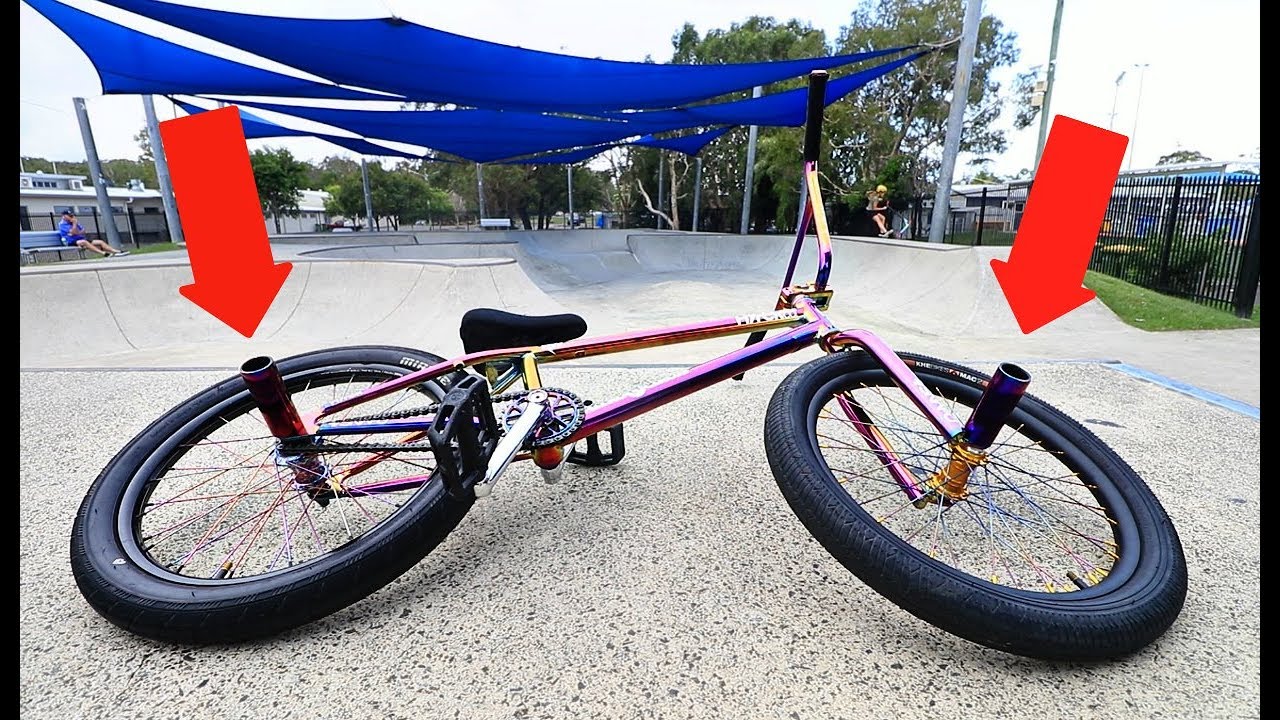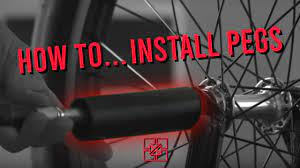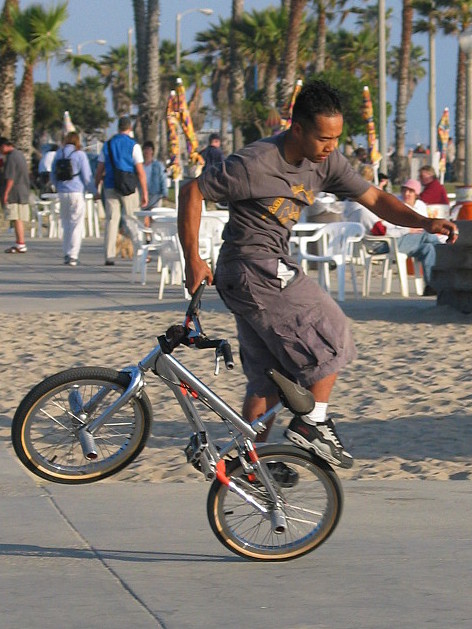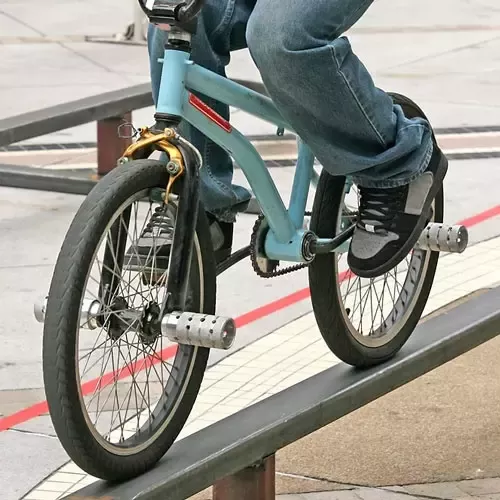Ever taken a closer look at those little protrusions sticking out of the wheels on some bikes? You know, bike pegs?
No doubt you’ve seen them. Have you ever what are bike pegs for?
Bike pegs may seem insignificant, but in reality, these small components hold the power to transform your cycling experience.
Think about it like this – just as salt brings out flavors in food that otherwise might remain hidden, bike pegs bring an added dimension to biking.
Intrigued yet? Keep reading and we’ll explore everything from their different types and unique features to how exactly they enhance your ride. Plus we’ll dive into practical guides for installation and maintenance!
By the end, you’ll have acquired a comprehensive knowledge of how to pick and use these items in your routine.
Table Of Contents:
- Exploring the World of Bike Pegs
- Different Types of Bike Pegs and Their Unique Features
- The Many Purposes and Uses of Bike Pegs
- A Comprehensive Guide to Installing Bike Pegs
- Key Manufacturers and Brands in the Bike Peg Industry
- Safety Considerations When Using Bike Pegs
- Maintenance and Care for Your Bike Pegs
- Tips and Techniques for Using Bike Pegs Effectively
- Bike Peg FAQs
- The Verdict – Should I or should I not?
Exploring the World of Bike Pegs
 Bike pegs might seem like small and insignificant parts of a bike, but they’re more than just metal cylinders. These tiny components can dramatically transform your cycling experience.
Bike pegs might seem like small and insignificant parts of a bike, but they’re more than just metal cylinders. These tiny components can dramatically transform your cycling experience.
Bike pegs, also known as stunt pegs, are typically used in BMX bikes for freestyle and street tricks. But that’s not all they’re good for. They give an extra spot to rest your feet or even let a friend hitch a ride.
The world of bike pegs is surprisingly diverse. From material choices such as steel, aluminum, or plastic coated; to different lengths suited for various riding styles; there’s something out there for everyone. Understanding these variations will help you choose the perfect set tailored to your biking needs.
Different Materials Make A Difference
Peg materials significantly affect their weight and durability – two crucial factors in choosing which ones suit you best. Steel pegs are generally heavier but offer superior strength compared to lighter-weight alternatives like aluminum or plastic-coated versions.
A study on bicycle frame materials by ResearchGate highlights how material selection influences performance: similarly, selecting the right bike peg involves balancing between personal preference and functional requirements.
Sizing Up Your Options
In addition to material choice, size matters when it comes down to picking up suitable bike pegs. The size of the peg affects its functionality and compatibility with your bike. For instance, longer pegs are ideal for tricks involving multiple foot placements while shorter ones might be more suited to everyday casual use.
It’s fascinating how such a small component can bring about big changes in cycling experiences.
Different Types of Bike Pegs and Their Unique Features
There’s a wide array of bike pegs out there, each tailored to meet different needs. The three main types are plastic, steel, and aluminum.
 Plastic Bike Pegs
Plastic Bike Pegs
The go-to choice for beginners is often plastic bike pegs. They’re light on the wallet and even lighter in weight. But don’t let that fool you into thinking they’re not sturdy; many models come with a reinforced inner core for added strength.
Besides their budget-friendly price tag, another benefit is reduced friction compared to metal counterparts. This makes them ideal for certain tricks like grinding rails or ledges where sliding ease matters.
Steel Bike Pegs
Moving up the durability scale brings us to steel bike pegs. These heavy-duty companions offer maximum strength which is why professional riders often prefer them despite being heavier than other options.
If you ride hard and frequently perform stunts requiring robust support, steel might be your best bet. However, keep in mind that these can wear down over time when used extensively on concrete surfaces because of their higher friction coefficient.
Aluminum Bike Pegs
Aluminum pegs strike a balance between weight and strength. They’re lighter than steel but more durable than plastic, making them an excellent middle-ground option.
Their relatively low friction makes them suitable for tricks while still offering substantial durability. One potential drawback is that they may not withstand heavy-duty use as well as steel pegs do, especially on harsh surfaces.
In the end, choosing the right bike peg comes down to your riding style and requirements. Each type has its pros and cons which you need to weigh before deciding on one.
The Many Purposes and Uses of Bike Pegs
Pegs, those small cylindrical parts attached to the wheel axles, are more than just an aesthetic addition. They serve a variety of practical purposes that can truly elevate your cycling experience.
Performing Tricks
One common use for bicycle pegs is performing tricks on BMX bikes. The extra surface area they provide makes it easier for riders to execute impressive stunts like grinds or spins. Check out this guide from Red Bull, where you can learn about some basic grinding techniques.
Providing Extra Space for Passengers
If you often have company while biking, having bike pegs could be quite beneficial. These sturdy extensions give passengers a spot to place their feet without interfering with the rotation of your wheels.
Cargo Support
In case you need help carrying stuff around, pegs come in handy too. Strap a bag onto them or balance items carefully – suddenly, your ride becomes more utilitarian.
Aiding in Cycling Maneuvers
You might not realize it but having these little accessories installed gives better control over various maneuvers such as sharp turns or sudden stops because they allow redistribution of weight effectively. Cycling Weekly’s article on safe cycling practices provides valuable insight into how gear contributes towards overall safety and control during rides.
As you can see, pegs are small but mighty. Give bicyle pegs a try if you’re looking for an extra level of adaptability on your ride, making it more than just transportation. Whether you’re into BMX tricks or simply need an easier way to carry things around town, consider giving these helpful accessories a shot.
A Comprehensive Guide to Installing Bike Pegs
 Installing pegs is a straightforward process, but there are important steps to follow. So let’s break it down.
Installing pegs is a straightforward process, but there are important steps to follow. So let’s break it down.
1. Gathering the Right Tools
To start, you’ll need some basic tools: a socket wrench and the correct size of socket for your bike’s axle nuts. You may also want some grease on hand to make sure everything runs smoothly.
2. Removing Your Bike’s Axle Nuts
The first step in installing your bicycle pegs is removing the axle nuts from either side of your wheel using your wrench and socket. Be careful not to lose these; they’re crucial.
3. Fitting Your Bike Pegs onto The Axles
Next up, fit the new peg over each exposed axle end – this should be an easy push-fit if you’ve chosen correctly sized pegs for your bicycle model. Here’s our guide on choosing the right-sized peg. Once done, reattach those all-important axle nuts securely with help from that trusty wrench again.
4. Tighten Everything Up Securely
You’ll now need to tighten everything back up securely. This ensures stability when riding or performing tricks – we don’t want any wobbly bits. But remember not too tight as this could potentially damage threads or parts. Park Tool has a great guide on understanding torque concepts.
Remember: safety first. Always make sure to inspect your work before taking off on a ride. If uncertain, don’t be shy to solicit aid or consult with a specialist.
5. Maintenance is Key
Once your pegs are installed, make sure they’re maintained well to get the most use out of them. Regular checks and tightening will keep everything running smoothly.
This guide should give you a good start on installing mountain bike pegs, but remember: practice makes perfect.
Key Manufacturers and Brands in the Bike Peg Industry
The bike peg industry is dominated by several key players known for their top-notch products. One such manufacturer is Odyssey BMX, a name synonymous with high-quality, durable biking pegs.
Odyssey BMX has built its reputation on innovation and quality. Their commitment to pushing boundaries can be seen in their product line, which includes the popular G-Sport Pleg 2+1 that offers unmatched durability due to its unique plastic-over-metal design.
Besides Odyssey BMX, another bike brand worth mentioning is Merritt BMX. This company’s attention to detail makes it stand out from others. Merritt’s SL1 sleeves are made of super hard materials making them resistant to wear-and-tear even under extreme conditions.
In addition to these two giants, there’s also The Shadow Conspiracy (TSC), who’ve carved a niche for themselves with innovative designs like the S.O.D Peg System Featherweight Option – an ingenious blend of strength and lightness.
- TSC: Known for creating reliable gear using advanced technology.
- Merritt: Praised for meticulous manufacturing processes resulting in robust equipment.
- Odyssey: Renowned for pioneering new designs and materials in the bicycle peg industry.
Each of these manufacturers brings something unique to the table. Their skill, enthusiasm and dedication to improving your biking experience are displayed in their products.
To choose from this plethora of options can be overwhelming. But understanding your specific needs will help you make an informed decision. So whether it’s about performing tricks or adding extra space for passengers, remember that the best bicycle peg is one that suits your requirements perfectly.
Safety Considerations When Using Bike Pegs
While bicycle pegs can add an exciting element to your biking experience, it’s crucial to prioritize safety. The right precautions will help you avoid potential injuries and ensure a fun ride.
 Riding with Extra Passengers
Riding with Extra Passengers
Bike pegs often let you carry extra passengers. But remember, most bikes are designed for single riders. Adding more weight may affect balance and control.
To make sure of a safe ride when carrying passengers, start by practicing in a controlled environment like Safe Kids Worldwide recommends. This helps get used to the additional weight before hitting public roads.
Performing Tricks Safely
Bicycle pegs open up new possibilities for tricks and stunts. Yet these moves need practice and skill – so don’t rush into them. Always wear protective gear such as helmets or knee pads during trick sessions.
You might also consider attending workshops from certified trainers like those at the National BMX Association.
Maintaining Your Bike Pegs
Regular maintenance is key to keep your bicycle pegs in top shape because worn-out or loose parts pose serious risks.
Cleaning after every use removes dirt that could impact performance while periodic tightening prevents loosening during rides. For thorough guidance on maintaining various types of biking pegs, refer to this comprehensive guide by BikeRadar.
Respecting Traffic Rules and Regulations
Biking, like any other form of transportation, has its rules. Even with bicycle pegs installed, it’s crucial to respect traffic laws for everyone’s safety.
The National Highway Traffic Safety Administration (NHTSA) offers excellent resources on road etiquette for cyclists.
Maintenance and Care for Your Bike Pegs
Caring for your bike pegs isn’t rocket science, but it’s definitely an art. These tiny components can take a beating during rides, especially if you’re into stunts or tricks. So, let’s explore how to keep them in tip-top shape.
Regular Cleaning
A clean bike is a happy bike – this applies even more so to its pegs. Regular cleaning helps remove grime that could potentially damage the surface of your pegs over time. You don’t need fancy equipment; a simple cloth and some warm water will do the trick.
If there are stubborn dirt spots on your pegs, use mild soap along with water. But remember: always dry them thoroughly after washing to prevent rusting.
Inspection and Tightening
Riding rough terrains can loosen up things quite easily including our sturdy little friends – the bike pegs. Make sure they’re securely fastened by giving them regular checks.
If you notice any wobbling while riding, it might be due to loose bike pegs which needs immediate attention as this could lead to accidents.
Lubrication Is Key
Just like squeaky door hinges get on everyone’s nerves, rusty or stiff bicycle parts also scream out loud for help. That’s why lubricating these small yet significant parts is important.
A light coating of oil-based lubricant will keep away rust while ensuring smooth operation when performing those jaw-dropping BMX tricks or simply accommodating an extra rider behind you.
Remember folks- maintenance is not a chore, it’s an investment in your bike’s longevity and performance. So get that cloth out and let the pampering begin.
Tips and Techniques for Using Bike Pegs Effectively
Mastering bicycle pegs isn’t rocket science, but it does need a bit of finesse. Whether you’re doing tricks or carrying an extra passenger, understanding how to use these little metal wonders effectively can make your ride smoother.
Peg Positioning: It’s All About Balance
Your feet placement on the pegs is key. When performing stunts like wheelies or bunny hops, positioning your feet closer to the center of the peg helps with balance. Bicycling Magazine suggests that this provides better control over weight distribution and movement.
The Art of Turning With Pegs
If you think turning with bike pegs is tricky business, we hear you. But once mastered, it adds style to every move. The trick lies in shifting your body weight towards the direction of turn while maintaining foot contact on both front and rear pegs.
Maintaining Momentum During Tricks
To pull off smooth tricks using bike pegs, momentum plays a crucial role. A sudden stop during any stunt might lead to imbalance; hence keeping up speed becomes vital here. In addition, ExtremeSportsX recommends tucking knees close when airborne for better mid-air maneuverability.
- Foot position matters: Closest to center aids balance during stunts.
- Weight shift: Shift body weight towards turn direction for easy turns.
- Maintain momentum: Keep up speed to avoid imbalance during tricks.
Learning how to use pegs effectively is a journey of trial and error. But with practice, you’ll be turning heads at the park in no time. Remember that safety should always come first; so make sure your helmet’s on before you start practicing these tips.
Bike Peg FAQs
What is a bike peg?
A bike peg is a cylindrical piece, usually made of metal or plastic, that attaches to the axles of your bicycle for additional foot support or trick execution.
Do pegs fit all bikes?
No. Pegs are not universal. They need to match with your axle’s diameter and thread pitch. Always check compatibility before buying.
Are pegs on bikes safe?
Bicycle pegs are safe if used correctly and maintained properly. However, they can pose risks when misused or neglected.
The Verdict – Should I or should I not?

Bike pegs, those little add-ons, can change the game…
By now you’ve delved into their types and features. You’ve seen how they serve multiple purposes from tricks to passenger space.
You’re ready with installation know-how and familiar with key brands in the bicycle peg industry.
Safety? Checked. Maintenance tips for longevity? Got it.
Remember: a small step like adding a bike peg could make your tricks that much cooler. So go ahead, try them sometime!

 Plastic Bike Pegs
Plastic Bike Pegs Riding with Extra Passengers
Riding with Extra Passengers